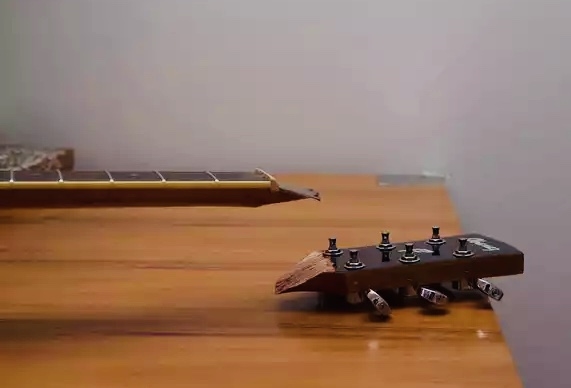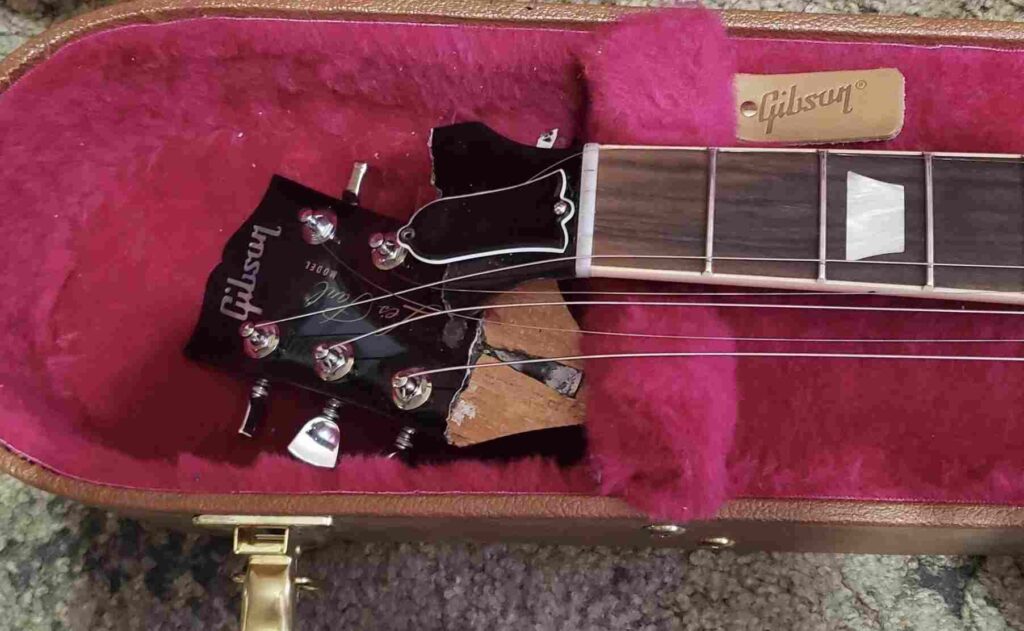Guitars have a habit of breaking, unfortunately. And it’s often the headstock that is the place where the break occurs.
It may be because they’re the most fragile parts of the guitar or take the most impact when we inevitably drop them. Whatever it is headstocks get cracked, snapped and broken all the time.
So if you want to know whether you can fix a broken guitar headstock, if cracks are fatal and how much it’s costs to get it repaired then this guide is for you. We’ll help you figure out if your damaged headstock can be saved!
Can you Fix a Broken Headstock on a Guitar?
Yes, you can fix a guitars broken headstock. Although it’s probably best you don’t attempt to do it yourself!
Fixing a broken headstock is generally a job for a professional. You should find a luthier who is experienced in repairing guitars.
If you must try to fix it yourself then prepare first and be careful. Without knowing what you’re doing or having the right tools there’s a good chance to you will make it worse. You could cause more problems and damage further or ruin your guitar completely.

Inspecting the break is important too. The cleaner it is the better chance of doing it yourself and it being straightforward. If it’s messier or looks difficult to perfectly align then a professional is, again, going to be your best bet.
But if it looks clean and you’re going to do it yourself then get the necessary tools and equipment first. At a minimum you will need:
- Glue
- Clamps
- Paper Towels
- Something to keep the neck propped up
Don’t rush into it. Planning and doing some dry clamping (that’s clamping before you apply the glue) is essential.
You need to be sure the broken pieces are aligned properly before you glue it. So practising and getting comfortable with what you’re going to do before doing the real thing will help.
This on Instructables is really clear and shows a simple step by step guide to fixing a broken headstock. Following that will give you a good chance of doing it right.
Can you Fix a Cracked Guitar Headstock?
Yes, cracks in headstocks can be fixed. They also tend to be easier and simpler to fix than a full break or snap.
Fixing a cracked headstock comes down to applying glue between the crack and then clamping it together until it’s set.
You’ll probably want to do a dry run first: finding a way to hold the neck up so you can work on it and practice the clamping.
After that it’s just a case of applying glue, clamping it together and then cleaning up the excess glue.
You should probably leave it to dry for 12 hours minimum (the glue instructions will guide you).
Fixing the finish is the trickiest part and difficult to do yourself. If you don’t mind it not looking perfect then go ahead and fix it on your own.
But if you need it to look perfect then it’s best to take it to a luthier from the start. Let them handle the repair and they’ll be able to do the refinishing work too.
How Much Does it Cost to Repair a Guitar Headstock?
If you’d prefer to get a professional to fix a cracked or broken headstock then the price will vary. It will depend on the severity of the damage and whether you want a full refinish.
For a simple glue job for a crack or break it may be as little as $100. A full refinish on top of the fix could be up to $400.
A good idea is to ask your local luthiers for an estimate of the cost. That way you can decide whether you’re going to try and fix it yourself, get a luthier to do it but ignore the finish or get it fixed with a refinish.

Is it Worth it?
If you are thinking of paying someone to fix your broken headstock you need to consider whether it’s worth it. There’s no point paying $300 to fix a guitar that is only worth $200.
For a more valuable guitar or one you are particularly attached to then the price may not be an issue. But for something not very expensive or that you really care about it might be better value to cut your losses and buy a new guitar.
Why are Guitar Headstocks so Vulnerable to Breaking?
Headstocks break a lot because of their construction and position. The strings on a guitar exert an awful lot of strain and pressure on the neck and headstock.
As the headstock is located at the top of the guitar it makes it more likely to get knocked or hit. Also if the guitar is dropped or falls the tip of the headstock often makes contact with the floor first and so gets snapped.
There are other factors as well. The grain of the wood is where the strength of is found and so plays a big role in the durability of the headstock.
On an angled headstock the wood used to make it is usually from the same piece as the neck. The angle means the grain isn’t continuous and is going in a different direction.
In turn the string tension isn’t going with the grain but passing through it. This becomes a weak spot that is vulnerable to breaking.
Les Paul’s are famously known for getting broken headstocks for that reason. The angled headstock is generally a weaker construction than the flat headstocks with no change in grain direction you find on many Fender guitars.
Conclusion
You should now feel more confident about whether you can fix a broken headstock and how to do so.
Whilst headstocks are the most likely part of the guitar to break it doesn’t mean your guitar is doomed. Thankfully they can usually be fixed and with no aftereffects to how they sound or play.
Either take it to a professional luthier or if you feel confident attempt to do it yourself. Be sure to practice and plan ahead if so and you should be able to fix a clean break without major issues.
Breaking your guitar, especially for the first time, can be worrying and upsetting but hopefully you now feel a bit more reassured.
Hi Andy . I have a few guitars and Les Paul styles are my favourite. I have a Vintage Lemon Drop which has a reversed bridge pick up which gives it an excellent sound. The stand it was on broke and the guitar fell and the headstock snapped. I want to try and fix it myself but I am wary. Would you recommend it being done professionally?
Hi Ian,
If you’ve got little to no experience with fixing a broken headstock and it’s a guitar you really like I would get a professional to do it.
Think of it this way – if you made a mistake and ruined the guitar, how upset would you be? If a lot then it makes sense to get someone who you should be able to rely on to do the job properly. Alternatively if you don’t care that much then you can go ahead and try yourself knowing you might do something wrong but ultimately won’t be that bothered.
I have a beaten up old Squier that I’ve modified and tested things out on simply for that reason. If I mess it up and wreck the guitar or make it unplayable I don’t really care. It’s a cheap way to learn without putting the guitars I genuinely love at risk.
Best of luck with it!